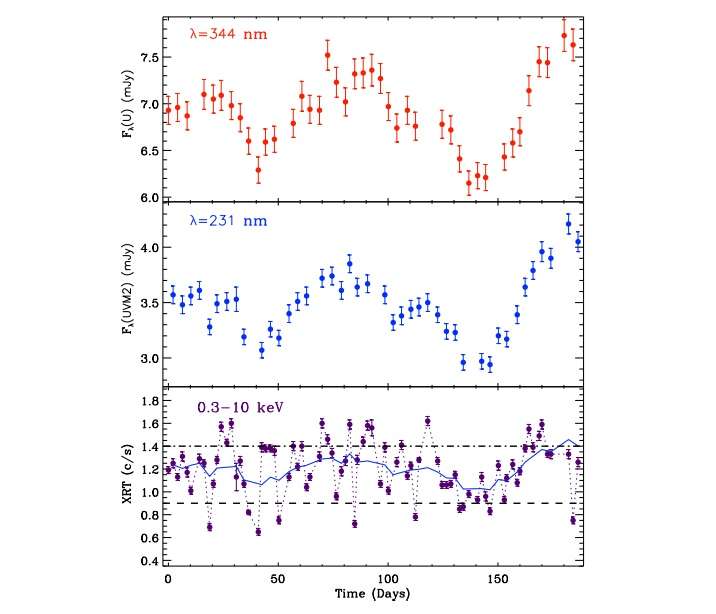October 18, 2016 report
Prototypical active galaxy Arakelian 120 observed by Swift

(Phys.org)—Astronomers using NASA's Swift space observatory, have conducted a long-term monitoring campaign of a prototypical active galaxy, designated Arakelian 120 (Ark 120 for short). These observations reveal crucial information about the galaxy's variability, giving a hint about its true nature. The findings are presented in a paper published Oct. 13 on the arXiv pre-print server.
Ark 120 was classified as a luminous "bare" Seyfert 1 galaxy as its nucleus is free from significant reddening or contamination from the host galaxy. As a rare example of a bright Seyfert 1 galaxy that is not significantly affected by any kind of complex absorption, Ark 120 was a target of numerous past observations. Due to the fact that this active galaxy stands out among bright Seyfert galaxies and is a highly variable source over the entire spectrum, it makes it a perfect target for monitoring with Swift.
A team of astronomers, led by Mario Gliozzi of the George Mason University in Fairfax, Virginia, carried out a series of Swift observations between September 2014 and March 2015 to investigate Ark 120. Such multi-wavelength monitoring observations that track variable behavior are much promising for scientists investigating active galactic nuclei (AGN) residing at the centers of active galaxies.
Ark 120 has a central black hole with a mass of about 150 million solar masses. According to the paper, the observations confirm the presence of significant large-amplitude variability for such a large black hole mass in all bands probed by Swift's Ultraviolet/Optical Telescope (UVOT) and X-Ray Telescope (XRT). The results show that the X-ray band is by far the most variable component, and indicate that the temporal variability of Ark 120 is associated with spectral changes of the X-rays and also of the broadband spectral energy distribution.
"The spectral analysis based on model fitting of flux-selected spectra confirms the existence of spectral variability during the Swift campaign of Ark 120 revealed by the model independent spectral variability analysis, with steeper spectra observed when the source has higher count rate," the researchers wrote in the paper.
The team found that the strong variability in X-ray and UV bands occurs on all timescales investigated by the Swift campaign. Additionally, the continuous temporal variability of Ark 120 appears to be associated with persistent spectral variability based on various model-independent analyses. Moreover, the spectral analysis allowed the team to conclude that the steeper-when-brighter behavior is caused by the steepening of the photon index.
In general, the Swift observations provided a wealth of data that helped the scientists to reveal the nature of Ark 120. The study confirms that it behaves as a typical Seyfert galaxy with persistent X-ray and also UV flux variability associated with spectral variability, where the spectrum softens as the source brightens.
"This spectral behavior too is common to the vast majority of Seyfert galaxies. However, the 'bare' nature of Ark 120 ensures that the spectral variability is caused by intrinsic changes in the primary emission, rather than being associated with variations of the absorber surrounding the source," the paper reads.
More information: Long-term monitoring of Ark 120 with Swift, arXiv:1610.04104 [astro-ph.HE] arxiv.org/abs/1610.04104
Abstract
We report the results of a six-month Swift monitoring campaign of Ark120, a prototypical bare Seyfert1 galaxy. The lack of intrinsic absorption combined with the nearly contemporaneous coverage of the UV and X-ray bands makes it possible to investigate the link between the accretion disk and the Comptonization corona. Our observations confirm the presence of substantial temporal variability, with the X-rays characterized by large-amplitude flux changes on timescales of few days, while the variations in the UV bands are smoother on timescales of several weeks. The source also shows spectral variability with the X-ray spectrum steepening when the source is brighter. We do not detect any correlation between the UV flux and the X-ray spectral slope. A cross correlation analysis suggests positive delays between X-rays and the UV emission, favoring a scenario of disk reprocessing. Although the strength of the correlation is moderate with a delay not well constrained (7.5+-7 days), it is nevertheless indicative of a large disk reprocessing region, with a separation between the X-ray and the UV emitting regions of the order of 1000 rG. The Ark120 correlation results are in agreement with those obtained in similar monitoring studies. When combined together, the observations can be well described by a linear relation between the X-ray/UV delay and the black hole mass. Within the context of the simplest scenario where these delays correspond to light-travel times, the implied distance between the X-ray source and the UV disk reprocessing region is of the order of many hundreds of gravitational radii.
© 2016 Phys.org





















